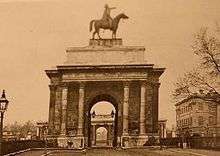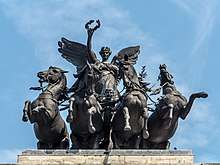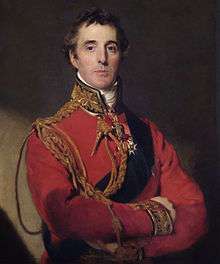Wellington Arch
Coordinates: 51°30′9″N 0°9′3″W / 51.50250°N 0.15083°W

Wellington Arch, also known as Constitution Arch or (originally) the Green Park Arch, is a triumphal arch forming a centrepiece of Hyde Park Corner in central London between corners of Hyde Park and Green Park — it sits on a large traffic island having crossings for pedestrian access. Built nearby between 1826 and 1830 to a design by Decimus Burton, it was moved to the site in 1882–1883. It once supported an equestrian statue of the 1st Duke of Wellington. Its designers planned a sculpted dark quadriga, an ancient four-horse chariot — which has been mounted on it since 1912.
History
%2C_p326.jpg)
Both the Wellington Arch and Marble Arch (originally sited in front of Buckingham Palace) were planned in 1825 by George IV to commemorate Britain's victories in the Napoleonic Wars. The Wellington Arch was also conceived as an outer gateway to Constitution Hill and therefore a grand entrance into central London from the west. The presence of a turnpike gate at this point had led, in the 18th century, to a strong perception that this was the beginning of London (reflected in the nickname for Apsley House as "No 1, London") and the arch was intended to reflect the importance of the position.
The arch was built between 1826 and 1830 to a design by Decimus Burton. It was planned as part of a single composition with Burton's screen that forms the Hyde Park Corner entrance to Hyde Park. The arch was originally positioned directly to the south of the screen, with the end of Constitution Hill re-aligned to meet it squarely, to form a corresponding entrance to a grand ceremonial route towards Buckingham Palace. Apsley House, the London residence of the Duke of Wellington, adjoins the screen.
The arch has a single opening, and uses the Corinthian order.[1] Much of the intended exterior ornamentation was omitted as a cost-saving exercise necessitated by the King's overspending on the refurbishment of Buckingham Palace, which was underway at the same time. A contemporary account, written in anticipation of its completion to its original plan, describes what was intended.
The entabulature is loft and elegant with a richly sculptured frieze, and a row of boldly projecting lions' heads on the cymatium, marking the centres of columns and other sub-divisions of the order. Above the entablature, on a lofty blocking course, is raised an attic, the body of which is embellished with a sculptural representation of an ancient triumph. On each of the columns is a statue of a warrior, and on the summit of the acroterium which surmounts the attic is a figure in a quadriga or ancient four horse chariot.[1]
Wellington Statue

In 1846 the arch was selected as a location for a statue of Arthur Wellesley, 1st Duke of Wellington, soldier and Prime Minister. The bronze Wellington Statue by Matthew Cotes Wyatt which eventually crowned the arch was at 40 tons (40.62 tonne) and 28 feet (8.53 m) high, the largest equestrian figure ever made.[2]
It generated considerable controversy and ridicule at the time. Motions were put in place to move it to a different location but as this could have been seen as insulting to Wellington it was left in place on the orders of the Queen and remained there throughout the remainder of the Duke's lifetime.
Relocation

In 1882–1883 the arch was moved a few yards south east to Hyde Park Corner to facilitate a road widening scheme; it lost its marking of the entrance of Hyde Park, to be on-axis with Constitution Hill, marking its entrance more than before. The site later became a large traffic island, split off from the west end of Green Park.
When the arch was rebuilt in its new position, the Wellington statue was not replaced. It was removed to Aldershot, and a smaller equestrian statue of the duke was commissioned from Joseph Edgar Boehm to stand on a plinth nearby. Decimus Burton had originally envisaged a sculpture of a quadriga on top of the arch.[3] His intentions were finally realised in 1912, with the installation of a bronze designed by Adrian Jones. It is based on a smaller original which caught the eye of Edward VII at a Royal Academy exhibition. The sculpture depicts Nike, the winged goddess of victory, descending on the chariot of war, holding the classical symbol of victory and honour, a laurel wreath. The face of the charioteer leading the quadriga is that of a small boy (actually the son of Lord Michelham, who funded the sculpture). The angel of peace was modelled on Beatrice Stewart.[4] The statue is the largest bronze sculpture in Europe.
Public access
The arch is hollow inside and until 1992 housed the smallest police station in London. Transferred to the ownership of English Heritage in 1999, it is open to the paying public: three floors of exhibits detailing the history of the arch, an Exhibition 'Waterloo 1815; The Battle for Peace' and high terraces on both sides of the arch with views of the surrounding area.[5] One half of the arch functions as a ventilation shaft for the Hyde Park Corner road underpass, constructed in 1961–62.[6]
See also
References
- 1 2 Elmes, James (1827). Metropolitan Improvements in the Nineteenth Century. London: Jones and Co. p. 134.
- ↑ Campbell Dixon, Anne. "Anne Campbell Dixon explores the history of Wellington Arch, which has just been reopened after a long-overdue restoration Making a grand entrance once again". Telegraph Travel. Retrieved 30 August 2012.
- ↑ "The Wellington Statue and Hyde Park Corner". Daily News (London). 28 March 1884.
- ↑ "Obituary – Sir Patrick Leigh-Fermor". The Daily Telegraph. London. 10 June 2011.
- ↑ "Wellington Arch Things to do - English Heritage". www.english-heritage.org.uk. Retrieved 2 April 2018.
- ↑ Ian Mansfield (6 January 2014), Hyde Park Corner’s Massive Hidden Ventilation Shaft (IanVisits blog)
External links

- Page at English Heritage incl. opening hours
- Wellington Arch Victorian-era postcard
